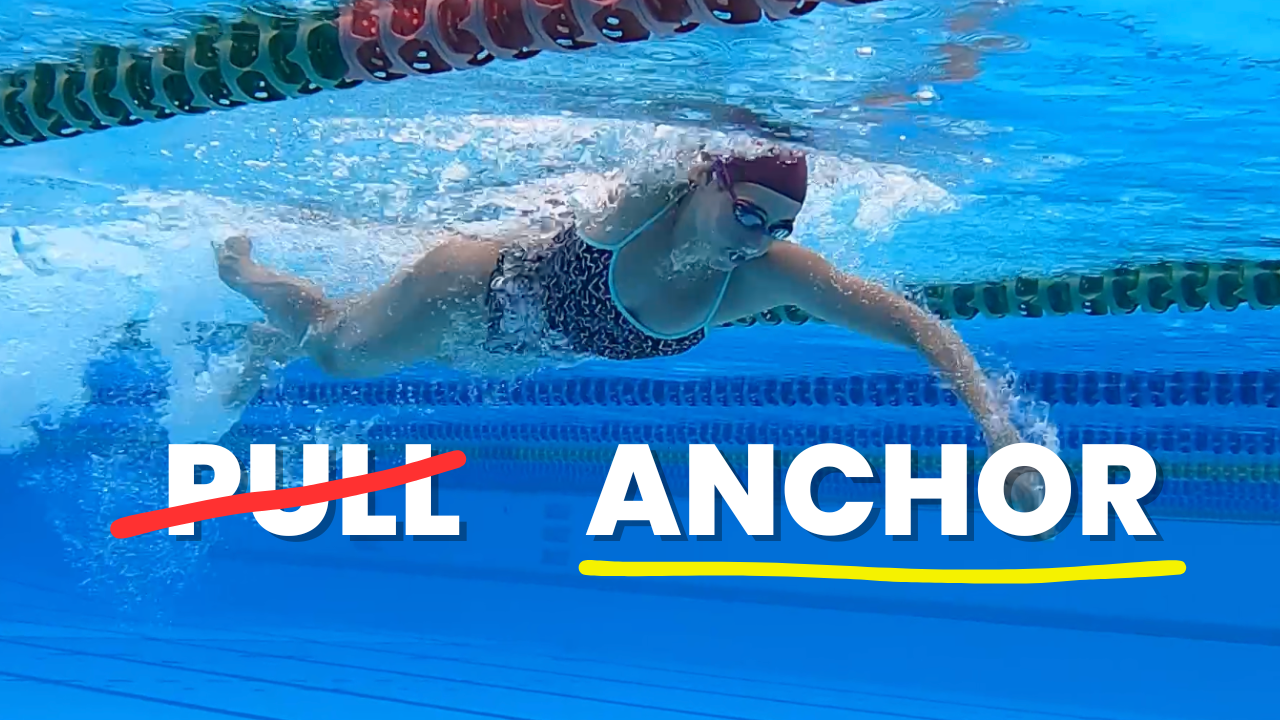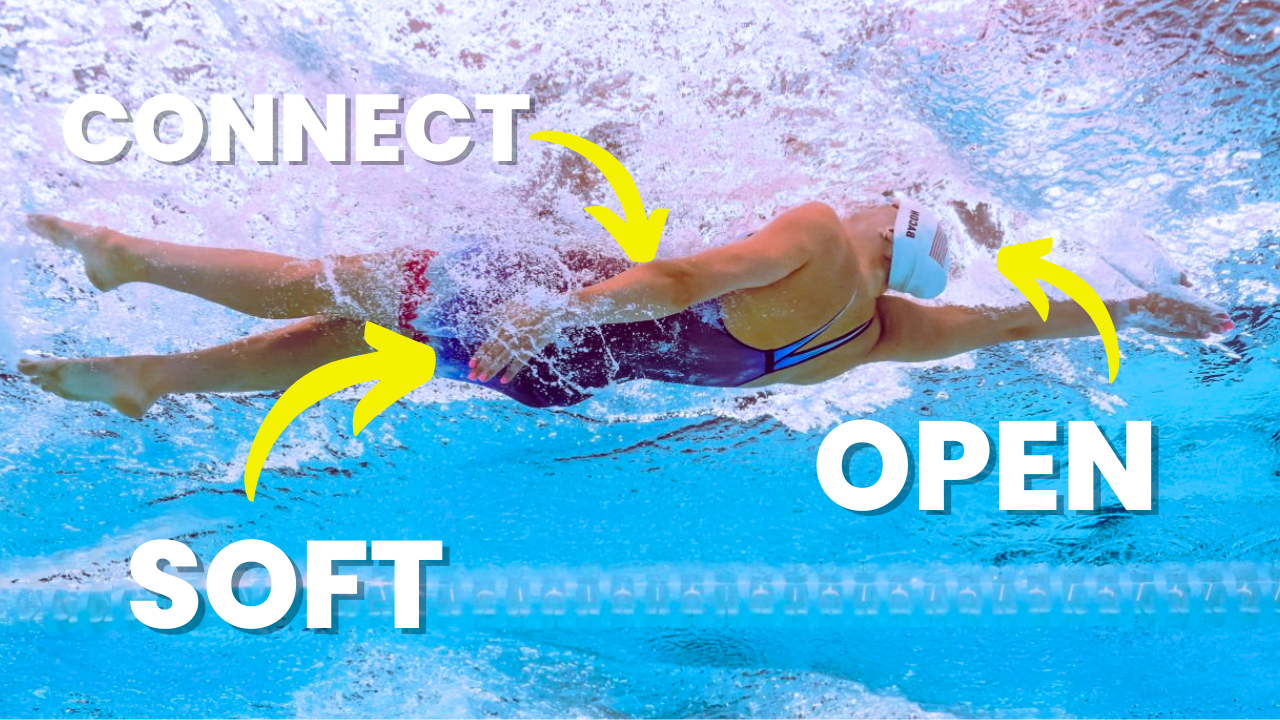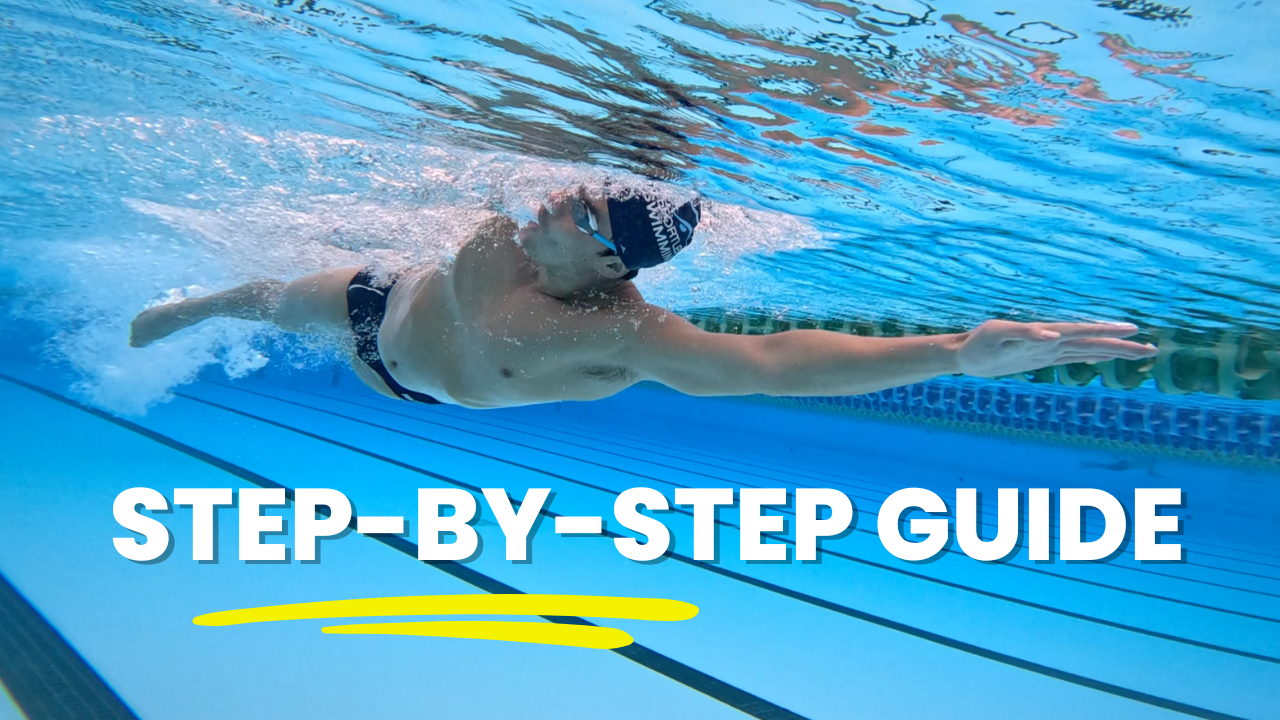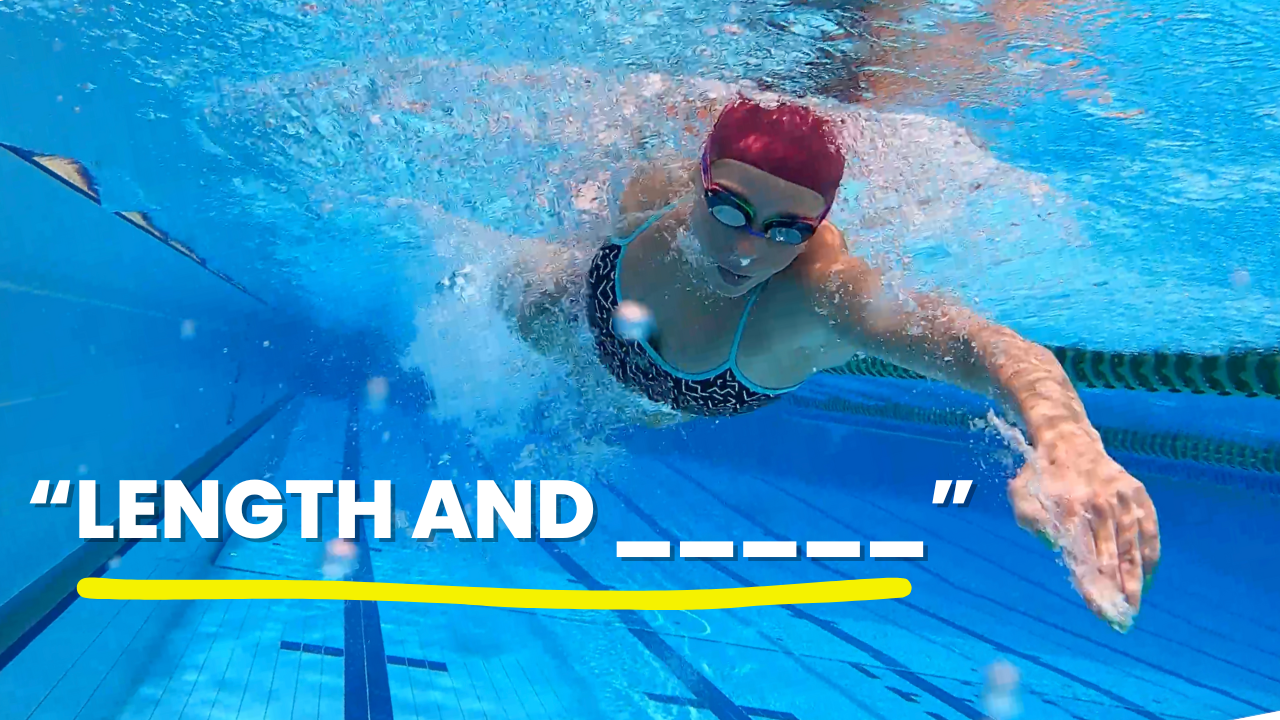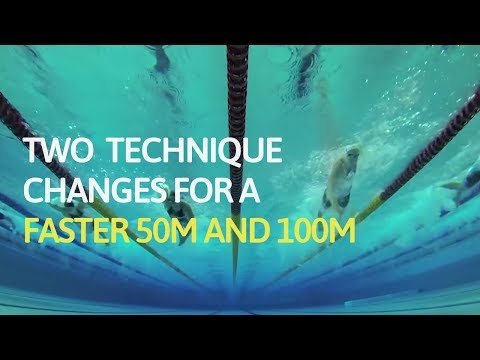Our coach Mitch Patterson (Australian Representative in the 50m and 100m Butterfly) breaks down this swimmers catch and pull in detail. He looks at how: The pitch of the hand changes too dramatically causing her to lose propulsion. A wideout sweep where the hand goes wider than the elbow is much less powerful. The ‘S’ shape pull is the correct path of the hand, but it’s only a very slight ‘S’ shape.
Transcription:
And be as subtle as you can with the hand pitch in the pull through. To make sure that you don’t release the water.
Hey, Brenton here. Welcome to this week’s episode of Feedback Friday. Today’s episode is done by Mitch Patterson. He’s been a coach with us for the last couple of years, and he’s been the Australian swim team for the 50 and the hundred butterfly. Now, Mitch has worked with hundreds of different swimmers over the last few years at our clinics and camps, and you’ll see that Mitch looks at things in a very similar way that I do, but he’s got a slightly different take and different perspective and a different way to explain things. I find that when you’re wanting to improve your swimming, it doesn’t hurt to get a different perspective. So you’ll see in this analysis that Mitch will probably pick up some slightly different things and explain them in a different way, and that can be a very good thing when it comes to swimming faster. So let’s get into today’s episode. Let me know in the comments below what you think of this analysis, and don’t forget to like and subscribe. Hit that notification bell to get notified every time we release a new video. Here we go.
Hey, Mitch here from Effortless Swimming. Today we’re looking at the swim technique of Sarah from Alberta, Canada, and we’re going to be looking at three key areas of her stroke where she can improve. At present, she’s demonstrating quite a straight arm catch in a stroke, so we’ll be looking at ways that we can help her venture into a high elbow catch for increased efficiency and strength and power. The other two areas that we’ll be looking at are quite minor but still, make a big difference. The first area of those minor ones is making sure that the fingertips and hands are in line with the forearm when reaching out in front, and then the other minor one is making sure that the change in hand pitch in the pull-through is more subtle and smaller, as opposed to wider and greater.
As you can see here, when Sarah pulls through, you can just see right here how great the hand pitch change is resulting in, I believe, a slight loss of grip and power in the stroke. You don’t want to release the water through that at the change in hand pitch, so as best as possible, making sure the hand is facing somewhat back for the most part of the stroke. Okay, so we’re going to dive into the two minor things first, and then get into the high elbow catch. As Sarah reaches into the water and stretches her arm out in front, we can just see here that her fingertips and hands are raised above the forearm here. We want to make sure that the hands and fingers are either in line with the wrist or slightly below, which can look something like this, or slightly lower down here.
All right. The reason why we don’t want these fingertips up high is, firstly, which is quite obvious, is that it increases your resistance when you’re swimming through the water. So there’s going to be a lot more water running into the hand there, causing a bit of resistance, which can slow you down somewhat.
The second thing is that I believe that in this instance, Sarah may have an air pocket under her hand. So that is one thing that it can also do is it can trap a pocket of air underneath the hand at the top there, which results in a loss of grip and a loss of sense and feel for the water, which can make it harder for you to work out whether you’ve got a hold of the water or not. Any sense of air under the hand will reduce your grip anyway. So having your fingertips lower reduces your resistance and it stacks the chances that you’ll have a high elbow catch in your favor. So as best as possible, when reaching out in front, have you fingertips either in line with the forearm and wrist or slightly below. Sarah’s change in hand pitch is quite substantial and I think it is linked to the straight arm catch and the wideout sweep. So I’m just going to bring her a little bit closer so everybody can see.
So as we watch Sarah sweep straight and outwards here, her hand is quite wide and therefore, coming back into the in sweep, we’re watching down here, just observe the change in hand pitch as she comes into the in sweep. So as we’re watching now, we can actually see the thumb facing the screen as she sweeps inwards, which means that her little finger is facing back, meaning that the water is quite literally being swept to the side and then pushed back. So the general notion is that, understanding that a freestyle pull through can resemble an s, you want to have the picture in your mind of a very elongated and blunts, so you want to be much straighter with the s shape so as to make sure that the hand is facing somewhat backward for most of the pull through.
You want to reduce and be as subtle as you can with the hand pitch in the pull through to make sure that you don’t release the water pulling through. So I think this is really linked to a wide straight arm out sweep, she’s just going a little bit too wide and a little bit too straight. In order to continue pulling back effectively, she has to sweep inwards a little bit too much to make the stroke happen. So with that in your mind, reduce the hand pitch change as much as you can in your pull through. If you get into a high elbow catch or you develop your high elbow catch, your pull through will naturally be more of an s like shape, and you won’t have to worry too much about focusing on a great out sweep and a great in sweep and really focusing on that s like figure.
So as with the previous minor thing with her fingertips and this one, really good drills to practice this going to be things like single-arm freestyle, where you can just focus on fingertips lower, and then when you’re pulling through, making sure the change in hand pitch isn’t too great in the pull through. The other fantastic drill to think about is also the Y-M-C-A and the Y-M-C string of drills that are on the Effortless Swimming drill list. These ones are absolutely fantastic, and these drills cover and encompass so many aspects of the stroke and the pull through. Okay. So as we have a look at Sarah coming in and reaching out in front, we just observed that at the front of her stroke, she’s quite straight and quite locked with the elbow, and pushing straight down with the hand and arm at the front of the stroke, before really applying a backward pressure into the stroke at the back, getting forwards propulsion.
So from what we know about swimming catch, we want to make sure as best as possible that you can get somewhat a bent elbow at the front of the stroke. It doesn’t have to be full-on over the top like this, but we want to get somewhat bent at the elbow before applying a lot more of the acceleration through the stroke. So what I’m going to suggest here is at the front of Sarah’s stroke here that she initiates her catch a little bit sooner and I’d recommend putting a bit more focus on the fingertips to pull the fingertips downwards.
As the fingertips are being pulled downwards, that she lifts her elbow up as she does this. It’s only going to be quite a minor movement. It doesn’t have to be super huge. It can just be a minor movement, and I think this is going to initiate the catch a lot sooner and cause a bend in the elbow to occur. So there’s a couple of things I do want to talk about when doing this movement. So you got to go into the catch with a relatively flexible arm. So if you’re locked at the elbow, you want to make sure that your arm is straight but relaxed, so that you can get movement at the joints. You want to go into this with the idea that you’re going to position your arm before accelerating through. So think of it in terms of the strategy of the stroke.
You want to get your forearm and hand facing somewhat behind you. It doesn’t have to be over the top. You just need to get some bend in the elbow at the front of the stroke to really get more power and efficiency in your pull through. So in relation to Sarah’s technique here, she’s going to be feeling feedback from the straight arm pull almost immediately. So one of the biggest limitations in going from a straight arm pull to a bent arm catch, I think, is the changes in feedback that you get when you go from one technique to the other. So I’ve heard a lot of people tell me of their experiences about going to a bent arm catch, it feels like they get a lot less feedback from the water. It feels like they’re doing a lot less and it can feel like they seem to get a bit more water pressure later in the stroke.
This is just an illusion in your mind. You will need to think of, in terms of strategy, about bending your arm at the front of the catch, to get a much greater pull through throughout the stroke. So in this sense here, I imagine that when Sarah pulls down with her fingertips and lifts up with her elbow at the front of the stroke, she may get a lot less feedback from the water than previously and it may feel like she’s doing this stroke, this catch phase, a lot higher in the water. Her hand comes down quite deep. So anything with a high elbow catch will feel a little bit more elevated. Okay. So she could experience having a higher elbow and a higher pull through or something that resembles shallowness in the pull through.
So really good drills to work on this is going to be doggie scoop and Y-M-C-A, and the Y-M-C videos of drills, where you can really practice getting the bent arms at the front of the stroke and training the mind and body as to where these positions are without force. So it’s really good to be able to bend at the elbows and hold the elbows bent all the way through the catch through these drills, and then weave in a bit of power as you go through and practice those ideas in your stroke. So as we watch here, it’s quite straight at the elbows until very late in the stroke when Sarah’s pulling through. So working on a high elbow catch at the front, I believe will really help Sarah’s pull through and using doggie scoop and the Y-M-C drills will really benefit her.
Now the other thing is with this high elbow catch, when it comes time to breathe in relation to Sarah’s stroke here, so her left arm is going quite deep and then sweeping under her arm. In the time it’s taking Sarah’s are to drop, here, for example, you could actually start initiating with the fingertips now and in the time it’s taking to drop with a straight arm, you could actually be positioning yourself like this. You could actually be taking the time to do a high elbow catch at the front, and then, as it’s time to drive onto the next arm forwards, that high elbow will be in place for you to leverage off and accelerate forward.
So as I said before, really good drills to work on the high elbow catch is going to be the Y-M-C-A drills and the Y-M-C drills, where you can practice without forcing too much bending the elbows out in front and holding the bend in the elbows through the stroke. This will just make sure that you have those high leverage points and that power zone all the way through the stroke, and prevent you from pushing down at the front, increasing your energy usage but decreasing your forwards’ propulsion. I hope you liked the video. Please like and subscribe and we’ll see you guys next week.


